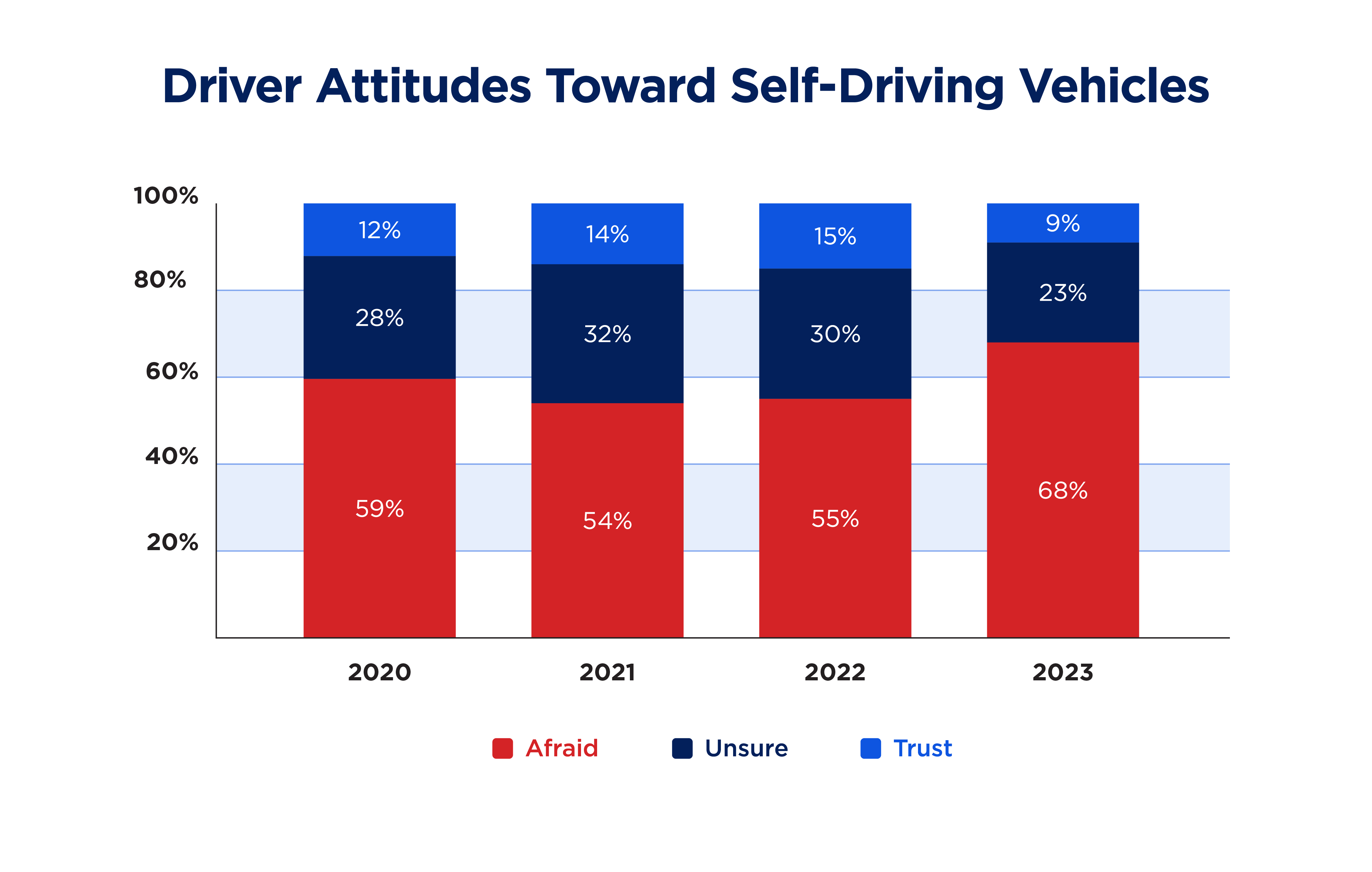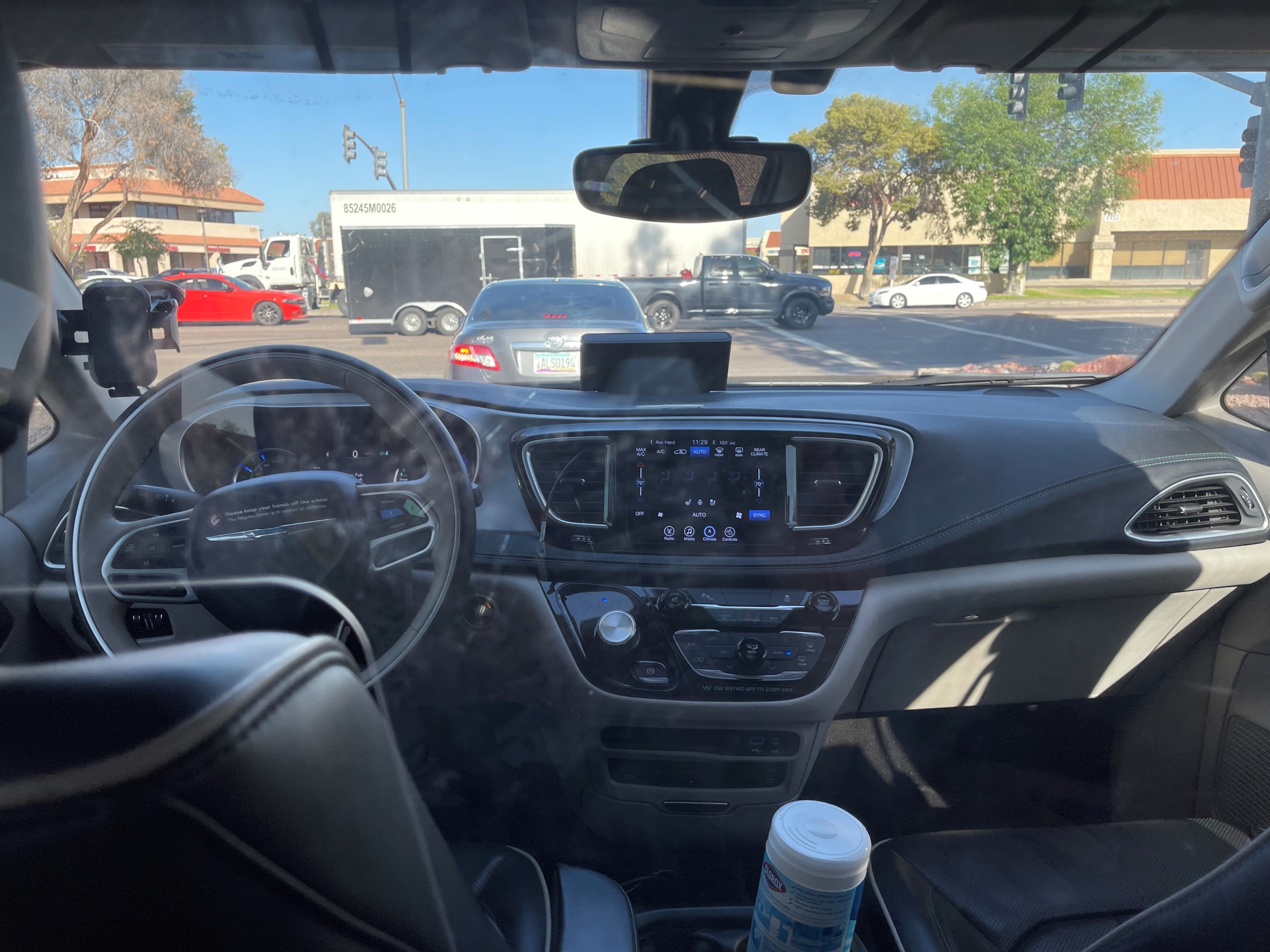PORTLAND, Ore., – A new survey from AAA shows that Americans are becoming more apprehensive about fully self-driving cars. At the same time, people are very interested in partially-automated vehicle technologies, which are widely available on newer vehicles.
This year’s survey finds that 68% are afraid of fully autonomous vehicles. This is a 13% jump from 55% in our 2022 survey – the biggest increase since 2020. Nine in ten (91%) U.S. drivers either would be afraid to ride in a self-driving vehicle (68%) or are unsure about it (23%). Only one in ten (9%) say they would trust a vehicle to drive itself while they are in it. AAA has done the Autonomous Vehicle (AV) Survey every year since 2016.

Here are links to B-roll video. The videos were shot by Marie Dodds riding in a Waymo autonomous vehicle in Tempe, Arizona. These videos are also available for download. Please reach out to marie.dodds@aaaoregon.com.
 Photo taken by Marie Dodds while riding in a Waymo autonomous vehicle in Tempe, AZ.
Photo taken by Marie Dodds while riding in a Waymo autonomous vehicle in Tempe, AZ.
“The increase in people’s fears surrounding fully automated vehicles likely stems from a number of high-profile crashes that occurred when drivers over-relied on current vehicle technologies,” says Marie Dodds, public affairs director for AAA Oregon/Idaho.
For example, the survey shows that nearly one in ten drivers believe they can buy a vehicle that drives itself while they sleep. Currently, there is no such vehicle available for purchase by the public that would allow someone to fully disengage from the task of driving.
These findings suggest improvements are still needed to build public trust and knowledge surrounding emerging vehicle technology. There is also a need to dispel confusion around automated vehicles.
AAA believes automakers must be diligent in promoting the use of more advanced vehicle technologies in a secure, reliable, and educational manner. This includes the consistent naming of vehicle systems available to consumers today.
“Names such as Autopilot, ProPILOT and Pilot Assist create the wrong assumption that vehicles can drive themselves,” adds Dodds. This year’s AAA survey found that 22% of Americans expect driver support systems with names like this to have the ability to drive the car by itself without any supervision, indicating a gap in consumer understanding. There are no vehicles currently available for sale in the U.S. that are fully automated and can operate without a driver.
AAA is partnering with automakers to create greater consistency across the industry. “Together, we can help consumers understand the type of technology their vehicle has along with how, when and where to use these systems, which will ultimately build trust in the vehicles of the future,” said Greg Brannon, director of automotive research for AAA.
Consumers are interested in ADAS
The new AAA survey finds that six in 10 U.S. drivers would “definitely” or “probably” want Advanced Driver Assistance Systems (ADAS) in their next vehicle. ADAS includes technologies such as adaptive cruise control, blind spot warning and automatic emergency braking. Check out AAA’s, Clearing the Confusion, which provides naming and descriptions of ADAS in a consistent, easy-to-understand manner.
Active driving assistance (ADA) is also considered ADAS, however, it differs in its functionality from other systems. ADA combines braking, accelerating, and steering through a combined use of adaptive cruise control and lane keeping assistance. This technology actively assists the driver versus other ADAS that only turns on when needed. ADA is also the only ADAS classified as Level 2 automation as defined by the Society of Automotive Engineers.
What is a fully self-driving vehicle?
It is a vehicle capable of operating without human involvement. A human driver is not required to control the vehicle at any time, nor required to be present in the vehicle while moving. These vehicles are not available for purchase by consumers and are classified as Level 5 automation as defined by the Society of Automotive Engineers.
Some fully autonomous vehicles are operating in the U.S., including the Waymo One ride-hailing service that operates in the Phoenix, AZ area. The B-roll videos shared at the link above were shot in such a Waymo vehicle.
About the survey
The survey was conducted January 13-17, 2023, using a probability-based panel designed to be representative of the U.S. household population overall. The panel provides sample coverage of approximately 97% of the U.S. household population. Most surveys were completed online; consumers without Internet access were surveyed over the phone.
A total of 1,140 interviews were completed among U.S. adults, 18 years of age or older, of which 949 qualified for the study. The margin of error for the study overall is 4.3% at the 95% confidence level. Smaller subgroups have larger error margins.
AAA has conducted its annual Autonomous Vehicle (AV) Survey since 2016; however, data is not comparable to years before 2020 due to change in methodology.
About AAA:
Started in 1902 by automotive enthusiasts who wanted to chart a path for better roads in America and advocate for safe mobility, AAA has transformed into one of North America’s largest membership organizations. Today, AAA provides roadside assistance, travel, discounts, financial and insurance services to enhance the life journey of more than 63 million members across North America, including over 56 million in the United States. To learn more about all AAA has to offer or to become a member, visit AAA.com.
AAA news releases, high resolution images, broadcast-quality video, fact sheets and podcasts are available on the AAA NewsRoom at NewsRoom.AAA.com.
Find local news releases at https://oregon.aaa.com/community/media/media-contacts.html

